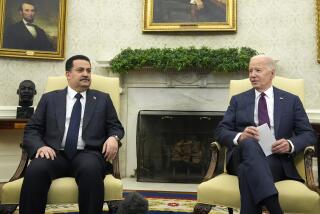Iraqis Seem to Be Leaving Kurdish City, Clinton Says
- Share via
WASHINGTON — President Clinton said Wednesday that Iraq appeared to be withdrawing its troops from Irbil, the Kurdish city that Iraqi forces invaded last week, but he cautioned that “it’s too soon to say” whether the pullback will be “permanent.”
Declaring the two rounds of U.S. missile strikes against Iraq on Tuesday and Wednesday a success, Clinton said Iraqi President Saddam Hussein “now knows that there is a price to pay for stepping over the line” set by the United Nations and the Western allies.
Clinton’s statement came as Iraqi military forces began testing the expanded “no-fly” zone imposed over southern Iraq by the Clinton administration--only to lie low after running into American and allied opposition.
Barely minutes after the broadened zone took effect at noon local time, two Iraqi MIG fighters approached allied aircraft that were monitoring the area. They retreated before reaching the new boundary just outside Baghdad’s southern border.
Shortly after that, the crew of an Iraqi SA-8 mobile missile battery briefly “illuminated,” or targeted, a U.S. Air Force F-16 fighter, prompting the American pilot to fire a high-speed anti-radar missile at the battery.
The Iraqi maneuvers, which followed back-to-back cruise missile attacks launched by U.S. air and naval forces Tuesday and Wednesday, were Baghdad’s first effort to challenge the American-ordered expansion of the “no-fly” zone over southern Iraq.
U.S. officials insisted that the missile attacks on Iraqi air defense systems were designed broadly to punish Hussein for his attack on Irbil--and to prevent a new Iraqi strike against Kuwait--rather than specifically to force Iraq to pull its troops out of the north.
Clinton asserted Wednesday that the U.S. action had “changed the strategic situation” in Iraq, leaving Hussein “strategically worse off” than he was before the strikes began. “I am satisfied that this was an appropriate, measured response,” he said.
One senior U.S. official predicted that Iraq would not challenge the expanded “no-fly” zone again and would soon withdraw the rest of its troops from the vicinity of Irbil.
Officials said U.S. intelligence reports had shown that Iraq had pulled back two of three divisions it had deployed in the Irbil area and was in the process of recalling the third. They also said that Iraqi units no longer were threatening surrounding cities.
“It’s a much quieter situation than it was 48 hours ago,” one U.S. official said.
But Defense Secretary William J. Perry warned that Iraq still had thousands of troops in the Irbil region, “and they are still in a very dangerous position.” He declined to forecast what the Iraqis would do.
The administration continued to defend itself Wednesday against criticism from some countries--notably France and Russia--that the U.S. acted improperly in launching attacks against Iraqi targets.
Secretary of State Warren Christopher flew to Europe on Wednesday and expanded his planned trip to focus on efforts to persuade the Western allies that being tough with Iraq was the only way to prevent Hussein from overstepping his bounds again.
At the same time, senior administration officials pointed out that French planes were continuing to help enforce the southern “no-fly” zone, and British Defense Minister Michael Portillo appeared with Perry at a news conference here to personally endorse the U.S. action.
The targeting of the U.S. F-16 by the Iraqi radar battery had been expected. Even after the U.S. missile raids Tuesday and Wednesday, Hussein had ordered his pilots to disregard any “no-fly” zone and to attack American warplanes whenever they could.
But U.S. officials dismissed the initial Iraqi probing. “What challenges . . . have occurred today, I would not characterize as serious,” Perry told reporters.
There was no immediate indication of precisely how successful the U.S. missile strikes had been. Perry said only that the bulk of the 14 targets that the United States had sought to destroy with cruise missiles in the attacks had been knocked out of action.
But, he said, he still had no firm report on whether the missile fired by the F-16 on Wednesday had destroyed the Iraqi missile battery.
Pentagon officials said they expected more detailed assessments of the missile damage later this week. They said it often takes several passes by a spy satellite or reconnaissance aircraft before full verification can be made.
U.S. officials said the Iraqi battery that targeted the F-16 was located north of the expanded “no-fly” zone in the south, but they added that the rules of engagement being followed by the allies allowed the pilot to fire.
U.S. officials said there had been reports earlier of a sizable explosion in downtown Baghdad, but they insisted that the United States had not taken any military action that would have been likely to cause it. The reports later proved to be erroneous.
Times staff writers Paul Richter in Washington and Norman Kempster, traveling with Secretary of State Christopher, contributed to this report.
More to Read
Sign up for Essential California
The most important California stories and recommendations in your inbox every morning.
You may occasionally receive promotional content from the Los Angeles Times.













